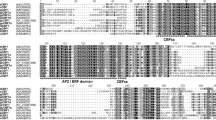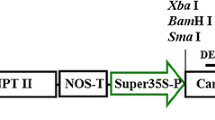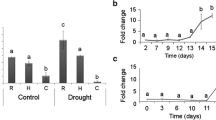Abstract
Key message
This work contributes in the identification and understanding of dehydrin genes and their function in the mechanisms of cold tolerance in eucalypt species.
Abstract
Dehydrins play a fundamental role in plant response and adaptation to abiotic stresses, having an important role in seed desiccation, response to abscisic acid, low temperatures, drought and salinity conditions. Eucalyptus nitens has a greater tolerance to cold than Eucalyptus globulus, which in part can be due to the role of dehydrins present in this species. This work reports the identification of four DHN genes in E. nitens and examines their response under low temperature, comparing them to those previously described in E. globulus. Transcript abundance of dehydrins increased when plants were cold acclimated, being higher in a freezing-resistant family of E. nitens than in a freezing-sensitive family. The relative levels of dhns in E. nitens were higher than the corresponding of E. globulus under the same conditions. The analysis of the promoter region for the four Enidhns showed that they contained several cold-or dehydration inducible cis elements, such as ABRE, MYC and CRT. The analyzes in the genomic sequence of dhn from E. globulus and E. nitens, together with the results of transcript abundance under cold acclimation, can be in part explained by differences found at the cis elements in the several DHN promoters studied. The most responsive gene to cold tolerance in both species was DHN2, which was used to obtain transgenic Arabidopsis thaliana containing either the coding region or the putative promoter. The EniDHN2 lines had higher transcript abundance than the A. thaliana with the EuglDHN2, although in both cases the transgenic lines had a higher survival rate to cold than the untransformed A. thaliana. In addition the EniDHN2 putative promoter drive induced higher expression levels of the gene (gus) marker than the one of E. globulus, when exposed to cold temperatures. Therefore, we hypothesize that the putative promoter of EniDHN2 and its coding region has a key role in conferring cold tolerance to this species.






Similar content being viewed by others
References
Allagulova CR, Gimalov FR, Shakirova FM, Vakhitov VA (2003) The plant dehydrins: structure and putative functions. Biochemistry 68:945–951
Amolkumar S, Arun S (2008) Signal transduction during cold stress in plant. Physiology and Molecular Biology of Plant 14:69–79
Brini F, Yamamoto A, Jlaiel L, Takeda S, Hobo T, Dinh HQ, Hattori T, Masmoudi K, Hanin M (2011) Pleiotropic effects of the wheat dehydrin DHN-5 on stress responses in Arabidopsis. Plant Cell Physiol 52:676–688
Campbell SA, Close TJ (1997) Dehydrins: genes, proteins, and associations with phenotypic traits. New Phytol 137:61–74. doi:10.1046/j.1469-8137.1997.00831.x
Chang S, Puryear J, Cairney J (1993) A simple and efficient method for isolating RNA from pine trees. Plant Mol Biol Report 11(2):113–116
Choi DW, Zhu B, Close TJ (1999) The barley (Hordeum vulgare L.) dehydrin multigene family: sequences, allele types, chromosome assignments, and expression characteristics of 11 Dhn genes of cv Dicktoo. Theor Appl Genet 98:1234–12478
Close TJ (1996) Dehydrins: emergence of a biochemical role of a family of plant dehydration proteins. Physiologia Plant 97:795–803
Close TJ (1997) Dehydrins: a commonality in the response of plants to dehydration and low temperature. Plant Physiol 100:291–296
Clough SJ, Bent AF (1998) Floral dip: a simplified method for Agrobacterium-mediated transformation of Arabidopsis thaliana. Plant J 16:735–743
Costa e Silva F, Shvaleva A, Broetto F, Ortunño MF, Rodrigues ML, Almeida MH, Chaves MM, Pereira JS (2008) Acclimation to shortterm low temperatures in two Eucalyptus globulus clones with contrasting drought resistance. Tree Physiol 29:77–86
Curtis M, Grossniklaus U (2003) A gateway cloning vector set for high-throughput functional analysis of genes in planta. Plant Physiol 133:462–469
Danyluk J, Perron A, Houde M, Limin A, Fowler B, Benhamou N et al (1998) Accumulation of an acidic dehydrin in the vicinity of the plasma membrane during cold acclimation of wheat. Plant Cell Online 10:623–638. doi:10.1105/tpc.10.4.623
Doyle JJ, Doyle JL (1987) A rapid DNA isolation procedure from small quantities of fresh leaf tissues. Phytochem Bull 19:11–15
Fernández M, Valenzuela S, Balocchi C (2006) RAPD and freezing resistance in Eucalyptus globulus. Electron J Biotech 9:303–309
Fernández M, Valenzuela S, Arora R, Chen K (2012a) Isolation and characterization of three cold acclimation-responsive dehydrin genes from Eucalyptus globulus. Tree Genetic Genomes 8:149–162
Fernández M, Valenzuela S, Barraza H, Latorre J, Neira V (2012b) Photoperiod, temperature and water deficit differentially regulate the expression of four dehydrin genes from Eucalyptus globulus. Trees 26:1483–1493
Fernández M, Villarroel C, Balbontín C, Valenzuela S (2010) Validation of reference genes for real-time qRT-PCR normalization during cold acclimation in Eucalyptus globulus. Trees Struct Funct 24(6):1109–1116
Fernández M, Troncoso V, Valenzuela S (2015) Transcriptome Profile in Response to Frost Tolerance in Eucalyptus globulus. Plant Mol Biol Report 33(5):1472–1485
Fowler S, Cook D, Thomashow MF (2005) The CBF cold response pathwat. In: Jenks MA, Hasegawa PM (eds) Plant Abiotic Stress. Blackwell publishing, Oxford, pp 71–99
Gilmour SJ, Fowler SG, Thomashow MF (2004) Arabidopsis transcriptional activators CBF1, CBF2 and CBF3 have matching functional activities. Plant Mol Biol 54:767–781
Guzmán M (2009) Análisis funcional y estructural del promotor del gen CBF-1 de Eucalyptus globulus en la respuesta a estrés por frío. Universidad de Chile, Santiago
Hara M, Terashima S, Fukaya T, Kuboi T (2003) Enhancement of cold tolerance and inhibition of lipid peroxidation by citrus dehydrin in transgenic tobacco. Planta 217:290–298
Hara M, Fujinaga M, Kuboi T (2004) Radical scavenging activity and oxidative modification of citrus dehydrin. Plant Physiol Biochem 42:657–662
Hara M, Kondo M, Kato T (2013) A KS-type dehydrin and its related domains reduce Cu-promoted radical generation and the histidine residues contribute to the radical-reducing activities. J Exp Bot 64:1615–1624
Harrison S, Mott E, Parsley K, Aspinall S, Gray J, Cottage A (2006) A rapid and robust method of identifying transformed Arabidopsis thaliana seedlings following floral dip transformation. Plant Methods 2:19
Houde M, Dallaire S, N’Dong D, Sarhan F (2004) Overexpression of the acidic dehydrin WCOR410 improves freezing tolerance in transgenic strawberry leaves. Plant Biotechnol J 2:381–387
Keller G, Bang Cao P, San Clemente H, Kayal WE, Marque C, Teulières C (2013) Transcript profiling combined with functional annotation of 2662 ESTs provides a molecular picture of Eucalyptus gunnii cold acclimation. Trees 27:1713–1735
Kim SY, Nam KH (2010) Physiological roles of ERD10 in abiotic stresses and seed germination of Arabidopsis. Plant Cell Rep 29:203–209
Koag MC, Fenton RD, Wilkens S, Close TJ (2003) The binding of Maize DHN1 to lipid vesicles. Gain of structure and lipid specificity. Plant Physiol 131:309–316
Komarnytsky S, Borisjuk N (2003) Functional analysis of promoter elements in plants. In: Setlow JK (ed) Genetic engineering: principles and methods, vol 25. Springer US, Boston, MA, pp 113–141. doi:10.1007/978-1-4615-0073-5_6
Kosová K, Vítámvás P, Prásil IT (2007) The role of dehydrins in plant response to cold. Biol Plant 51:601–617
Lång V, Palva ET (1992) The expression of a rab-related gene, rab18, is induced by abscisic acid during the cold acclimation process of Arabidopsis thaliana (L.) Heynh. Plant Mol Biol 20(5):951–962
Layton B, Boyd M, Bitonti B, Norman M, Dollahon R, Balsamo R (2010) Dehydration- induced expression of a 31-kDa dehydrin in Polypodium polypodioides (Polypodiaceae) may enable large, reversible deformation of cell walls. Am J Bot 97:535–544
Lois R, Dietrich A, Hahlbrock K, Schulz W (1989) Aphenylalanine ammonia-lyase gene from parsley: structure, regulation and identification of elicitor and light responsive cis-acting elements. EMBO J 8:1641–1648
Maruyama K, Todaka D, Mizoi J, Yoshida T, Kidokoro S, Matsukura S, Takasaki H, Sakurai T, Yamamoto YY, Yoshiwara K, Kojima M, Sakakibara H, Shinozaki K, Yamaguchi-shinozaki K (2012) Identification of Cis-Acting Promoter Elements in Cold- and Dehydration-Induced Transcriptional Pathways in Arabidopsis, Rice, and Soybean. DNA Res 19:37–49
Moraga P, Escobar R, Valenzuela S (2006) Resistance to freezing in three Eucalyptus globulus Labill subspecies. Electronic J of Biotech 9:310–314
Muñoz-Mayor A, Pineda B, García-Abellán J, Antón T, García-Sogo B, Sanchez-Bel P, Flores F, Atarés A, Angosto T, Pintor-Toro J, Moreno V, Bolarin M (2012) Overexpression of dehydrin tas14 gene improves the osmotic stress imposed by drought and salinity in tomato. J Plant Physiol 169:459–468
Nash J, Luehrsen KR, Walbot V (1990) Bronze-2 gene of maize: reconstruction of wild-type allele and analysis of transcription and splicing. Plant Cell 2:1039–1049
Navarro M, Ayax C, Martinez Y, Laur J, Kayal W, Marque C, Teulières C (2011) Two EguCBF1 genes overexpressed in Eucalyptus display a different impact on stress tolerance and plant development. Plant Biotechnol J 9:50–63
Nylander M, Svensson J, Palva T, Welin BV (2001) Stress-induced accumulation and tissue-specific localization of dehydrins in Arabidopsis thaliana. Plant Mol Biol 45:263–279
Pastuglia M, Rody D, Dumas C, Cock JM (1997) Rapid induction by wounding and bacterial infection of an S gene family receptor-like kinase gene Brasica oleracea. Plant Cell 9:49–60
Perdiguero P, Collada C, Soto A (2014) Novel dehydrins lacking complete K-segments in Pinaceae, the exception rather than the rule. Front. Plant Sci. 5:682. doi:10.3389/fpls.2014.00682
Pichersky E, Bernatzky R, Tanksley SD, Breidenbach RB, Kausch AP, Cashmore AR (1985) Molecular characterization and genetic mapping of two clusters of genes encoding chlorophyll a/b-biding proteins in Lycopersicon esculentum (tomato). Gene 40:247–258
Puhakainen T, Hess MW, Mäkelä P, Svensson J, Heino P, Palva T (2004) Overexpression of multiple dehydrin genes enhances tolerance to freezing stress in Arabidopsis. Plant Mol Biol 54:743–753
Qin F, Sakuma Y, Li J, Liu Q, Li YQ, Shinozaki K, Yamaguchi-Shinozaki K (2004) Cloning and functional analysis of a novel DREB1/CBF transcription factor involved in cold-responsive gene expression in Zea mays L. Plant Cell Physiol 45:1042–1052
Rasmussen-Poblete S, Valdes J, Gamboa MC, Valenzuela PDT, Krauskopf E (2008) Generation and analysis of an Eucalyptus globulus cDNA library constructed from seedlings subjected to low temperature conditions. E J Biotechnol 11(2):14
Robertson M, Cuming AC, Chandler PM (1995) Sequence analysis and hormonal regulation of a dehydrin promoter from barley, Hordeum vulgare. Physiol Plant 94:470–478
Rodríguez EM, Svensson JT, Malatrasi EM, Choi DW, Close ETJ (2005) Barley Dhn13 encodes a KS-type dehydrin with constitutive and stress responsive expression. Theor Appl Genet 110:852–858
Rorat T (2006) Plant dehydrins tissue location, structure and function. Cell Mol Biol Lett 11:536–556
Rouster J, Leah R, Mundy J, Cameron-Mills V (1997) Identification of a methyl jasmonate-responsive region in the promoter of a lipoxygenase 1 gene expressed in barley grain. Plant J 11:513–523
Sakai T, Takahashi Y, Nagata T (1996) Analysis of the promoter of the auxin-inducible gene, parC, of tobacco. Plant Cell Physiol 23:906–913
Sharabi-Schwager M, Lers A, Samach A, Guy CL, Porat R (2010) Overexpression of the CBF2 transcriptional activator in Arabidopsis delays leaf senescence and extends plant longevity. J Exp Bot 61:261–273
Shen Y, Tang MJ, Hu YL, Lin ZP (2004) Isolation and characterization of a dehydrin-like gene from drought-tolerant Boea crassifolia. Plant Sci 166:1167–1175
Shinozaki K, Yamaguchi-Shinozaki K (2000) Molecular responses to dehydration and low temperature: differences and cross-talk between two stress signaling pathways. Curr Opin Plant Biol 3:217–223
Shinozaki K, Yamaguchi-Shinozaki K, Seki M (2003) Regulatory network of gene expression in the drought and cold stress responses. Curr Opin Plant Biol 6:410–417
Stockinger EJ, Gilmour SJ, Thomashow MF (1997) Arabidopsis thaliana CBF1 encodes an AP2 domain-containing transcriptional activator that binds to the C-repeat/DRE, a cis-acting DNA regulatory element that stimulates transcription in response to low temperature and water deficit. Proc Natl Acad Sci U S A 94:1035–1040
Straub P, Shen Q, Ho D (1994) Structure and promoter analysis of an ABA-and stress-regulated barley gene, HVA1. Plant Mol Biol 26:617–630
Sun X, Lin HH (2010) Role of plant dehydrins in antioxidation mechanisms. Biologia 65:755–759
Teulieres C, Marque C (2007) Eucalyptus. In: Pua EC, Davey MR (eds) Biotechnology in agriculture and forestry 60, Transgenic Crops V. Springer, New York, pp 387–402
Thomashow MF (1999) Plant cold acclimation: freezing tolerance genes and regulatory mechanisms. Annu. Rev Plant Physiol Plant Mol Biol 50:571–599
Thompson JE, Legge RL, Barber RF (1987) The role of free radicals in senescence and wounding. New Phytol 105:317–344
Turnbull JW, Eldridge KG (1984) The natural environment of Eucalyptus as the basis for selecting frost-resistant species. In: Proceedings, IUFRO Colloque international sur les Eucalyptus résistants au froid, Bordeaux, Paris, pp 43–62
Viret JF, Mabrouk Y, Bogorad L (1994) Transcriptional photoregulation of cell-type-preferred expression of maize rbcS-m3: 3' and 5' sequences are involved. Proc Natl Acad Sci U S A 91(18):8577–8581
Vornam B, Gailing O, Derory J, Plomion C, Kremer A, Finkeldey R (2011) Characterization and natural variation of a dehydrin gene in Quercus petraea (Matt.) Liebl. Plant Biol 13:881–887
Wang Y, Xu H, Zhu H, Tao Y, Zhang G, Zhang L, Zhang C, Zhang Z, Ma Z (2014) Classification and expression diversification of wheat dehydrin genes. Plant Sci 214:113–120
Welling A, Rinne P, Viherä-Aarnio A, Kontunen-Soppela S, Heino P, Tapio Palva E (2004) Photoperiod and temperature differentially regulate the expression of two dehydrin genes during overwintering of birch (Betula pubescens). J Exp Bot 55:507–516
Wise M (2003) Leaping to conclusions: a computational reanalysis of late embryogenesis abundant proteins and their possible roles. BMC Bioinformatics 4:52
Xing X, Liu Y, Kong X, Liu Y, Li D (2011) Overexpression of a maize dehydrin gene, ZmDHN2b, in tobacco enhances tolerance to low temperature. Plant Growth Regul 65:109–118
Xu H, Yang Y, Xie L, Li X, Feng C (2014) Involvement of multiple types of dehydrins in the freezing response in Loquat (Eriobotrya japonica). PLoS One 9:87575
Zhu W, Zhang D, Lu X, Zhang L, Yu Z, Lv H, Zhang H (2014) Characterisation of an SKn-type dhydin promoter from wheat and its responsiveness to various abiotic and biotic stresses. Plant Mol Biol Rep 32:664–678
Acknowledgments
This research was supported by the project FONDECYT 1130780 from CONICYT and Genómica Forestal SA.
Author information
Authors and Affiliations
Corresponding author
Ethics declarations
Conflict of interest
The authors declare that they have no conflict of interest.
Additional information
Communicated by I. Porth.
Electronic supplementary material
Below is the link to the electronic supplementary material.
Rights and permissions
About this article
Cite this article
Aguayo, P., Sanhueza, J., Noriega, F. et al. Overexpression of an SKn-dehydrin gene from Eucalyptus globulus and Eucalyptus nitens enhances tolerance to freezing stress in Arabidopsis . Trees 30, 1785–1797 (2016). https://doi.org/10.1007/s00468-016-1410-9
Received:
Accepted:
Published:
Issue Date:
DOI: https://doi.org/10.1007/s00468-016-1410-9




